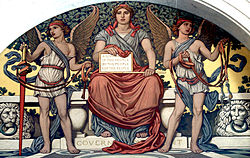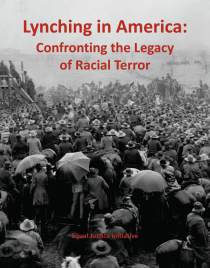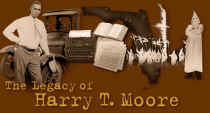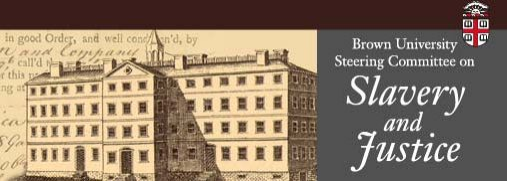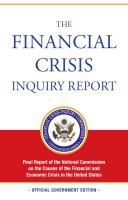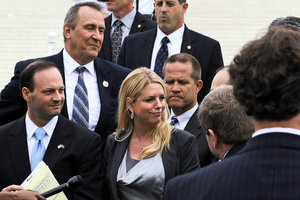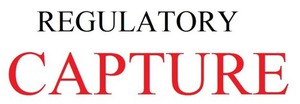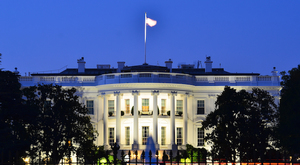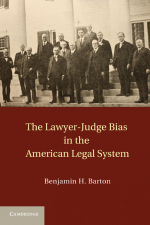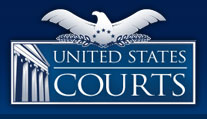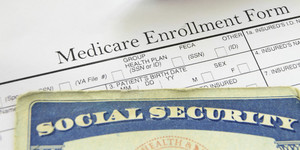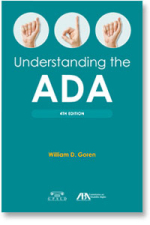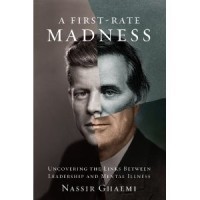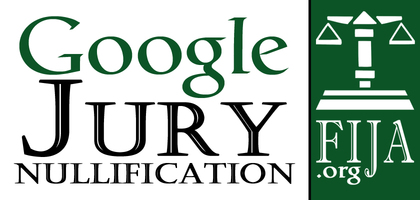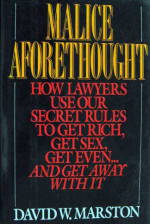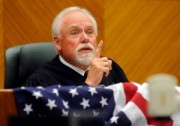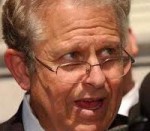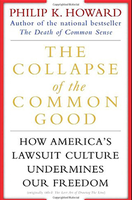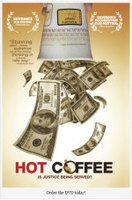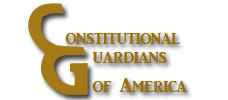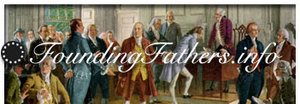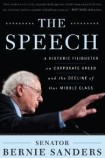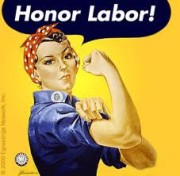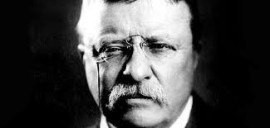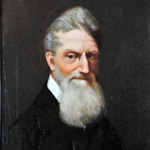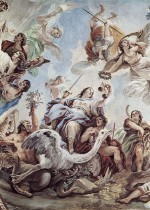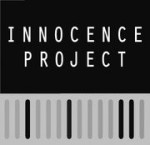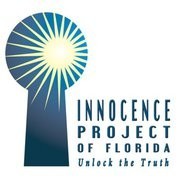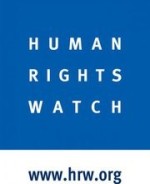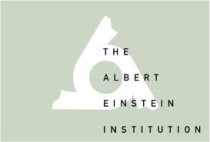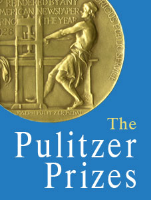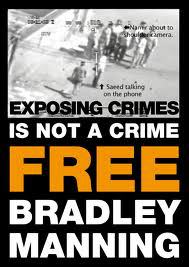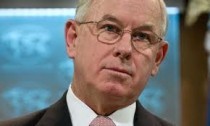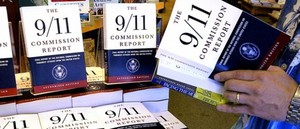Page under construction
Central Banking History
Central bank
Wikipedia
A central bank, reserve bank, or monetary authority is an institution that manages a state's currency, money supply, and interest rates. Central banks also usually oversee the commercial banking system of their respective countries. In contrast to a commercial bank, a central bank possesses a monopoly on increasing the monetary base in the state, and usually also prints the national currency,[1] which usually serves as the state's legal tender.
The primary function of a central bank is to control the nation's money supply (monetary policy), through active duties such as managing interest rates, setting the reserve requirement, and acting as a lender of last resort to the banking sector during times of bank insolvency or financial crisis. Central banks usually also have supervisory powers, intended to prevent bank runs and to reduce the risk that commercial banks and other financial institutions engage in reckless or fraudulent behavior. Central banks in most developed nations are institutionally designed to be independent from political interference.[2][3] Still, limited control by the executive and legislative bodies usually exists.[4][5]
The Rothschild Family
Banking Dynasty
Wikipedia
The Rothschild family is a family descending from Mayer Amschel Rothschild, a court Jew to the German Landgraves of Hesse-Kassel, in the Free City of Frankfurt, who established his banking business in the 1760s.[1] Unlike most previous court Jews, Rothschild managed to bequeath his wealth, and established an international banking family through his five sons,[2] who established themselves in Vienna, London, Paris and Naples, as well as Frankfurt.
During the 19th century, when it was at its height, the Rothschild family is believed by some to have possessed the largest private fortune in the world, as well as the largest private fortune in modern world history.[3][4][5] The family's wealth is believed to have subsequently declined, as it was divided amongst hundreds of descendants.[6] Today, Rothschild businesses are far less well known than they were throughout the 19th century, although they encompass a diverse range of fields, including finance, real estate, mining, energy, mixed farming, wine and charities.[7][8]
Waddesdon Manor in Waddesdon, Buckinghamshire, England.
The Rothschild Archive was established to preserve and arrange the record of a family that is widely recognised for the major contribution it has made to the economic, political and social history of many countries throughout the world. Read more
.........History of central banking in the United States.........
History of central banking in the United States
Wikipedia
This history of central banking in the United States encompasses various bank regulations, from early "wildcat" practices through the present Federal Reserve System.
Contents
1. 1781–1836: The Bank of North America; the First, and Second, Bank of the United States
1.1 Bank of North
America
1.2 First Bank of
the United States
1.3 Second Bank of
the United States
2. 1837–1862: "Free Banking"
Era
3. 1863–1913: National Banks
4. 1907 - 1913: Creation of the
Federal Reserve System
4.1 Panic of 1907
alarms bankers
4.2 Aldrich Plan
4.3 A regional
Federal Reserve system
4.4 Agrarian demands
partly met
5. The Federal
Reserve
6. References
7. External links
Bank of North America
Main articles: Bank of North America and Currency Act
Some Founding Fathers were strongly opposed to the formation of a central banking system; the fact that England tried to place the colonies under the monetary control of the Bank of England was seen by many as the "last straw" [verification needed] of oppression which led directly to the American Revolutionary War. [citation needed]
Others were strongly in favor of a central bank. Robert Morris, as Superintendent of Finance, helped to open the Bank of North America in 1782, and has been accordingly called by Thomas Goddard "the father of the system of credit and paper circulation in the United States." As ratification in early 1781 of the Articles of Confederation had extended to Congress the sovereign power to generate bills of credit, it passed later that year an ordinance to incorporate a privately subscribed national bank following in the footsteps of the Bank of England. However, it was thwarted in fulfilling its intended role as a nationwide central bank due to objections of "alarming foreign influence and fictitious credit," favoritism to foreigners and unfair policies against less corrupt state banks issuing their own notes, such that Pennsylvania's legislature repealed its charter to operate within the Commonwealth in 1785.
First Bank of the United States
Main article: First Bank of the United States
In 1791, former Morris aide and chief advocate for Northern mercantile interests, Alexander Hamilton, the Secretary of the Treasury, accepted a compromise with Southern lawmakers to ensure the continuation of Morris's Bank project; in exchange for support by the South for a national bank, Hamilton agreed to ensure sufficient support to have the national or federal capitol moved from its temporary Northern location, New York, to a "Southern" location on the Potomac. As a result, the First Bank of the United States (1791–1811) was chartered by Congress within the year and signed by George Washington soon after. The First Bank of the United States was modeled after the Bank of England and differed in many ways from today's central banks. For example, it was partly owned by foreigners, who shared in its profits. Also, it was not solely responsible for the country's supply of bank notes. It was responsible for only 20% of the currency supply; state banks accounted for the rest. Several founding fathers bitterly opposed the Bank. Thomas Jefferson saw it as an engine for speculation, financial manipulation, and corruption.[1] In 1811 its twenty-year charter expired and was not renewed by Congress. Absent the federally chartered bank, the next several years witnessed a proliferation of federally issued Treasury Notes to create credit as the government struggled to finance the War of 1812; a suspension of specie payment by most banks soon followed as well.
Second Bank of the United States
Main article: Second Bank of the United
States
See also: Bank War
After five years, the federal government chartered its successor, the Second Bank of the United States (1816–1836). James Madison signed the charter with the intention of stopping runaway inflation that had plagued the country during the five year interim. It was basically a copy of the First Bank, with branches across the country. Andrew Jackson, who became president in 1828, denounced the bank as an engine of corruption. His destruction of the bank was a major political issue in the 1830s and shaped the Second Party System, as Democrats in the states opposed banks and Whigs supported them. He was unable to get the bank dissolved, but refused to renew its charter. The end of the bank saw a period of runaway inflation which was purposefully engineered by the bankers[citation needed]. Jackson attempted to counteract this by executive order requiring all Federal land payments to be made in gold or silver. This produced the Panic of 1837, which lasted four years, but later recovered and produced more stable economic growth[citation needed].
1837–1862: "Free Banking" Era
In this period, only state-chartered banks existed. They could issue bank notes against specie (gold and silver coins) and the states heavily regulated their own reserve requirements, interest rates for loans and deposits, the necessary capital ratio etc. These banks had existed since 1781, in parallel with the Banks of the United States. The Michigan Act (1837) allowed the automatic chartering of banks that would fulfill its requirements without special consent of the state legislature. This legislation made creating unstable banks easier by lowering state supervision in states that adopted it. The real value of a bank bill was often lower than its face value, and the issuing bank's financial strength generally determined the size of the discount. By 1797 there were 24 chartered banks in the U.S.; with the beginning of the Free Banking Era (1837) there were 712.
During the free banking era, the banks were short-lived compared to today's commercial banks, with an average lifespan of five years. About half of the banks failed, and about a third of which went out of business because they could not redeem their notes.[2] (See also "Wildcat banking".)
During the free banking era, some local banks took over the functions of a central bank. In New York, the New York Safety Fund provided deposit insurance for member banks. In Boston, the Suffolk Bank guaranteed that bank notes would trade at near par value, and acted as a private bank note clearinghouse.[citation needed]
1863–1913: National Banks
The National Banking Act of 1863, besides providing loans in the Civil War effort of the Union, included provisions:
- To create a system of national banks. They had higher standards concerning reserves and business practices than state banks. Recent research indicates that state monopoly banks had the lowest long run survival rates.[3] The office of Comptroller of the Currency was created to supervise these banks.
- To create a uniform national currency. To achieve this, all national banks were required to accept each other's currencies at par value. This eliminated the risk of loss in case of bank default. The notes were printed by the Comptroller of the Currency to ensure uniform quality and prevent counterfeiting.
- To finance the war, national banks were required to back up their notes with Treasury securities, enlarging the market and raising its liquidity.
As described by Gresham's Law, soon bad money from state banks drove out the new, good money; the government imposed a 10% tax on state bank bills, forcing most banks to convert to national banks. By 1865, there were already 1,500 national banks. In 1870, 1,638 national banks stood against only 325 state banks. The tax led in the 1880s and 1890s to the creation and adoption of checking accounts. By the 1890s, 90% of the money supply was in checking accounts. State banking had made a comeback.
Two problems still remained in the banking sector. The first was the requirement to back up the currency with treasuries. When the treasuries fluctuated in value, banks had to recall loans or borrow from other banks or clearinghouses. The second problem was that the system created seasonal liquidity spikes. A rural bank had deposit accounts at a larger bank, that it withdrew from when the need for funds was highest, e.g., in the planting season. When combined liquidity demands were too big, the bank again had to find a lender of last resort.
These liquidity crises led to bank runs, causing severe disruptions and depressions, the worst of which was the Panic of 1907.
National banks issued National Bank Notes as currency. Because they were uniformly backed by US government debt, they generally traded at comparable values in contrast to the notes issued during the Free Banking era in which notes from different banks could have significantly different values. National bank notes were not however "lawful tender", and could not be used as bank reserves under the National Bank Act. The Federal government issued greenbacks which fulfilled this role along with gold.[4]
Congress suspended the gold standard in 1861 early in the Civil War and began issuing paper currency (greenbacks). The federally-issued greenbacks were gradually supposed to be eliminated in favor of national bank notes after the Specie Payment Resumption Act of 1875 was passed. However, the elimination of the greenbacks was suspended in 1878 and the notes remained in circulation. Federal debt throughout the period continued to be paid in gold. In 1879, the United States had returned to the gold standard, and all currency could be redeemed in gold. [5]
1907 - 1913: Creation of the Federal Reserve System
Panic of 1907 alarms bankers
Early in 1907, New York Times Annual Financial Review published Paul Warburg's (a partner of Kuhn, Loeb and Co.) first official reform plan, entitled "A Plan for a Modified Central Bank," in which he outlined remedies that he thought might avert panics. Early in 1907, Jacob Schiff, the chief executive officer of Kuhn, Loeb and Co., in a speech to the New York Chamber of Commerce, warned that "unless we have a central bank with adequate control of credit resources, this country is going to undergo the most severe and far reaching money panic in its history." "The Panic of 1907" hit full stride in October. [Herrick]
Bankers felt the real problem was that the United States was the last major country without a central bank, which might provide stability and emergency credit in times of financial crisis. While segments of the financial community were worried about the power that had accrued to JP Morgan and other 'financiers', most were more concerned about the general frailty of a vast, decentralized banking system that could not regulate itself without the extraordinary intervention of one man. Financial leaders who advocated a central bank with an elastic currency after the Panic of 1907 included Frank Vanderlip, Myron T. Herrick, William Barret Ridgely, George E. Roberts, Isaac Newton Seligman and Jacob H. Schiff. They stressed the need for an elastic money supply that could expand or contract as needed. After the scare of 1907 the bankers demanded reform; the next year, Congress established a commission of experts to come up with a nonpartisan solution.
Aldrich Plan
Rhode Island Senator Nelson Aldrich, the Republican leader in the Senate, ran the Commission personally, with the aid of a team of economists. They went to Europe and were impressed with how the central banks in Britain and Germany appeared to handle the stabilization of the overall economy and the promotion of international trade. Aldrich's investigation led to his plan in 1912 to bring central banking to the United States, with promises of financial stability, expanded international roles, control by impartial experts and no political meddling in finance. Aldrich asserted that a central bank had to be, paradoxically, decentralized somehow, or it would be attacked by local politicians and bankers as had the First and Second Banks of the United States. The Aldrich plan was introduced in 62nd and 63rd Congresses (1912 and 1913) but never gained much traction as the Democrats in 1912 won control of both the House and the Senate as well as the White House.
A regional Federal Reserve system
Main article: Federal Reserve System
The new President, Woodrow Wilson, then became the principal mover for banking and currency reform in the 63rd Congress, working with the two chairs of the House and Senate Banking and Currency Committees, Rep. Carter Glass of Virginia and Sen. Robert L. Owen of Oklahoma. It was Wilson who insisted that the regional Federal Reserve banks be controlled by a central Federal Reserve board appointed by the president with the advice and consent of the U.S. Senate.
Agrarian demands partly met
William Jennings Bryan, now Secretary of State, long-time enemy of Wall Street and still a power in the Democratic party, threatened to destroy the bill. Wilson masterfully came up with a compromise plan that pleased bankers and Bryan alike. The Bryanites were happy that Federal Reserve currency became liabilities of the government rather than of private banks—a symbolic change—and by provisions for federal loans to farmers. The Bryanite demand to prohibit interlocking directorates did not pass. Wilson convinced the anti-bank Congressmen that because Federal Reserve notes were obligations of the government, the plan fit their demands. Wilson assured southerners and westerners that the system was decentralized into 12 districts, and thus would weaken New York City's Wall Street influence and strengthen the hinterlands. After much debate and many amendments Congress passed the Federal Reserve Act or Glass-Owen Act, as it was sometimes called at the time, in late 1913. President Wilson signed the Act into law on December 23, 1913.
The Federal Reserve
The Federal Reserve's power developed slowly in part due to an understanding at its creation that it was to function primarily as a reserve, a money-creator of last resort to prevent the downward spiral of withdrawal/withholding of funds which characterizes a monetary panic. At the outbreak of World War I, the Federal Reserve was better positioned than the Treasury to issue war bonds, and so became the primary retailer for war bonds under the direction of the Treasury. After the war, the Federal Reserve, led by Paul Warburg and New York Governor Bank President Benjamin Strong, convinced Congress to modify its powers, giving it the ability to both create money, as the 1913 Act intended, and destroy money, as a central bank could.
During the 1920s, the Federal Reserve experimented with a number of approaches, alternatively creating and then destroying money which, in the eyes of Milton Friedman, helped create the late-1920s stock market bubble.[6]
After Franklin D. Roosevelt took office in 1933, the Federal Reserve was subordinated to the Executive Branch, where it remained until 1951, when the Federal Reserve and the Treasury department signed an accord granting the Federal Reserve full independence over monetary matters while leaving fiscal matters to the Treasury.
The Federal Reserve's monetary powers did not dramatically change for the rest of the 20th century, but in the 1970s it was specifically charged by Congress to effectively promote "the goals of maximum employment, stable prices, and moderate long-term interest rates" as well as given regulatory responsibility over many consumer credit protection laws.
America's Forgotten War Against the Central Banks
America's Forgotten War Against the Central Banks
"Let me issue and control a nation's money supply, and I care not who makes its laws."
(Mayer Amschel Rothschild, Founder of Rothschild Banking Dynasty)
Many prominent Americans such as Benjamin Franklin, Thomas Jefferson, and Andrew Jackson have argued and fought against the central banking polices used throughout Europe.
A note issued by a central bank, such as the Federal Reserve Note, is bank currency. These notes are given to the government in exchange for an interest-bearing government bond. The primary means to
pay for the interest on these bonds is to borrow more bank notes, thus beginning a vicious cycle that ultimately ends with the complete destruction of the currency and bankruptcy of the nation.
History is replete with such occurrences. Read more





